This week we're exploring the science of sound and music. We sound out the human voice, hear why we all talk differently, and probe the origins of accents and the means by which impersonators mimic their victims. Also, we discover how a tune can act like cocaine in your brain and why, in some cultures, music can replace a lawyer! Also, we hear what's going on in the brains of Jazz musicians as they improvise, see how hungry sharks are similar to shoppers and find out why a big brown bat needs magnetic bat-nav. Plus, in kitchen science we discover the musical secrets of plastic bottles!
In this episode

Sharks and shoppers have something in common
With such a huge blue ocean to wander around, how exactly do marine predators like sharks find their next meal?
 Well, it turns out that instead of randomly swimming about, sharks and other marine hunters move about according to a particular set of rules that mean they are more likely to bump into something to eat.
Well, it turns out that instead of randomly swimming about, sharks and other marine hunters move about according to a particular set of rules that mean they are more likely to bump into something to eat.
For a while now, ecologists have studied the hunting behaviour of various animals including spider monkeys and discovered that they use something called a Levy Walk - this has a rather involved mathematical explanation, which essentially means that the animal undergoes lots of short-distance journeys interspersed with fewer longer-distance journeys. This is a better way of finding rare prey that is scattered in clumps across large areas of ocean.
Even our own fishing vessels and people out shopping are thought also use this strategy - if you're looking for a certain item in a supermarket, you might look carefully in one place and if you don't find what you want you move further to continue your search.
And now it seems that open ocean species do the same thing. David Sims from the Plymouth Marine Laboratory here in the UK, led and international team of researchers who collected and analysed diving data from tags attached to 31 marine creatures including sharks, cod, sea turtles and penguins.
What they found was that five out of the seven species tagged performed Levy Walks - they did lots of shorter dives then occasionally much longer dives. The team also created a virtual ocean on a computer which showed that these animals are much more likely to encounter prey by diving like this than if they simply wandered around.The interesting thing is that many different types of animals - including ourselves - seem to evolve similar general rules of how to forage. It could be really useful for other things like programming robots to collect samples from inaccessible locations like volcanoes and even other planets, and it could help us understand more about how our ancient ancestors explored and colonised distant shores
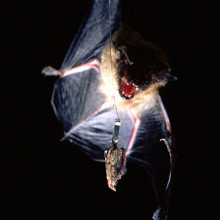
Bat Nav 2
Scientists have have found that a bar magnet is the basis of bats' direction-finding prowess.
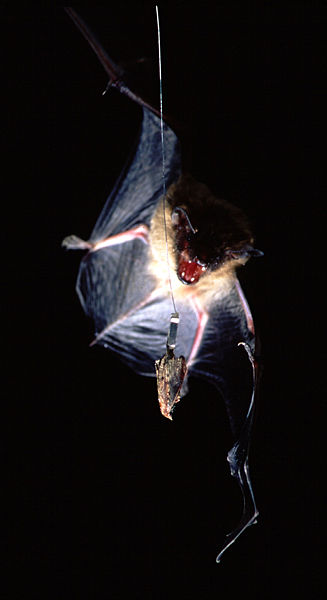 University of Leeds researcher Richard Holland and his colleagues exposed big brown bats (Eptesicus fuscus), which are renowed navigators, to a magnetic pulse 5000 times stronger that the Earth's own magnetic field.
University of Leeds researcher Richard Holland and his colleagues exposed big brown bats (Eptesicus fuscus), which are renowed navigators, to a magnetic pulse 5000 times stronger that the Earth's own magnetic field.
One group of the bats received a pulse aligned with the planet's field. The intention was that these animals would serve as a control to rule out any behavioural side effects caused by exposure to the magnetic pulse. The second group of animals received a pulse oriented in the opposite direction to the Earth's field, and the third group received no pulse at all.
The bats were then released 20 km north of their usual roosting sites and tracked with radio transmitters as they tried to find their way home. As expected the unmagnetised and the control animals all set off in the right direction, but about half of the animals that received the reverse-direction pulse initially flew off in totally the wrong direction.
This, say the researchers, suggests that the animals are using a neurological compass based on a magnetic iron compound called magnetite (Fe3O4). Crystals of the compound form small grains like miniature bar magnets which will swing around as the animal changes its position relative the the Earth's magnetic field. But a strong magnetic pulse like that used in the present experiment can reverse the poles of the magnetite compass, causing the animal to confuse north with south.
The team base their argument on observations from certain types of bacteria which naturally seek out magnetic north or south poles. These "magnetotacts", which also produce small magnetite crystals inside their cells, can also be converted from north-seeking to south-seeking forms by exposure to magnetic pulses.
But why did only half of the magnetised bats fly off in the wrong direction? The answer, the team suggests, is because they were testing the animals in their home territory and some of them could well have realised where they were using other cues, such as sight or smell, and this over-rode their flawed sense of direction.

Vanishing forests spell bad news for sea turtles
This week there is rather discomforting news of an unexpected link between environmental problems on land and those in the sea - it seems that cutting down rainforests in West Africa is damaging not only the forests and everything that lives in them but may also be harming endangered sea turtles.
 Gabon lies on the Atlantic coast of Africa, and around two thirds of its vast rainforests are being opened up to logging. Trees are felled and then floated down rivers to the coast where they are collected for export. But a lot of them get washed out to sea and end up on beaches where leatherback turtles are trying to nest.
Gabon lies on the Atlantic coast of Africa, and around two thirds of its vast rainforests are being opened up to logging. Trees are felled and then floated down rivers to the coast where they are collected for export. But a lot of them get washed out to sea and end up on beaches where leatherback turtles are trying to nest.
It might seem fairly trivial to have a few trees scattered around on a beach, but the effects can be quite serious. An international team of researchers led by William Laurance from the Smithsonian Tropical Research Institute in Panama has been studying turtle nesting beaches in Gabon and found that between 2002 and 2004 over ten percent of nesting attempts were aborted because logs got in the way of females trying to lay eggs. They also found that around a third of Pongara Beach, one of the world's most important leatherback nesting beaches, was clogged up with logs.
Conservationists want to see changes put in place to end the wasteful loss of trees and to help protect these important turtle nesting beaches. One problem is that under current laws, the misplaced logs belong to the Gabon government, so it's illegal to try and move them. And these are really valuable trees - around 11 thousand were counted on the beaches during the survey, worth in the region of 11 million dollars.
Things that could help the situation include the introduction of regulations to ban logging during turtle nesting seasons and to clear logs off beaches - but that would have to be done very carefully, so as not to disrupt the nesting sites even more.
Are hand driers greener than paper towels?
We're not sure about this one. Has anybody done the calculations? Are electric hand dryers actually greener than using paper towels?

17:03 - The Science of the Voice
The Science of the Voice
with Professor David Howard, University of York
David - Good Evening, Hi.
Chris - Thank you for coming down and joining us. Your research, very interesting, is actually on the voice: something which we on the radio can't do without.
David - It certainly is and, of course, is something nobody can do without in this day and age.
Chris - So how do you go about studying it?
David - Well, there are a number of things you can do. The most obvious thing is you can stick a microphone in front of people and look at the wiggles and try and make some sense of them. That needs to be done in combination with understanding how we create a sound. What are the key parts of our bodies we use when we create a sound? One of the things we've been looking at in the past is differences between people who sing or speak. For example, we've been looking at choristers in cathedrals to try and establish whether people can tell the difference between them singing and also to try and establish what it is that changes as boys and girls grow older.
 Chris - So you've given me some samples. Let me invite the audience to participate in a bit of a challenge then. You've given me two groups of choristers: one all boys, one all girls singing the same piece of music and we're going to see if we can get people to tell the difference.
Chris - So you've given me some samples. Let me invite the audience to participate in a bit of a challenge then. You've given me two groups of choristers: one all boys, one all girls singing the same piece of music and we're going to see if we can get people to tell the difference.
David - This is correct. The key thing when you're listening is to realize this is a choir singing so you need to listen to the top line of the choir.
Chris - So I'll pick one of these at random so here we go.
Choir Sample 1
Chris - Any thoughts Helen?
Helen - Just enjoying it, it's rather lovely. I don't know, I think I'm going to have to hear the next one to compare it to. It sounded fairly female to me.
Chris - Ok, should I play number two David?
David - Yeah, try number two.
Choir Sample 2
Chris - I have to say I cannot hear the difference myself and I've done quite a bit of singing in a lot of cathedrals and choirs.
David - Well I have to confess that I too have and listened to many children whilst making these recordings. I find it difficult to tell the difference. If you ask me to tell the difference I would struggle.
Chris - So if I let the cat out of the bag, the one I played first was the boys singing and Helen thought it was girls. The second was the girls singing. Does this then put the kibosh on this claim that you have to have all male choirs and especially all male treble choirs (boys) because they sound better than girls?
David - Well I believe it does. What we're demonstrating here is that given the same situation boys and girls can fulfill the role and do a job as good as each other. But it does come from other areas too because boys have been singing in cathedrals now for over half a millennium and girls have been singing since 1991. So they haven't got much of a head start in terms of catching up. This does show that at Wells Cathedral, which is where these recordings were made. Actually girls can do the job as well as boys.
Chris - And if you feed those recordings into a computer and ask it to build you a profile of what the voices actually look like does that give you any obvious standout differences between the boys and the girls?
David - No it doesn't. Interestingly, our ability to analyze things for the real subtlety of listening we cannot yet with a computer do as well as our ears.
Chris - Which makes a change doesn't it?
David - It does and it's rather nice I think that we haven't yet beaten the ear.
Chris - Ok, so let's zoom in on the business end: what's doing this? The whole vocal tract? Can you just give us a whistle-stop tour of this and how it works?
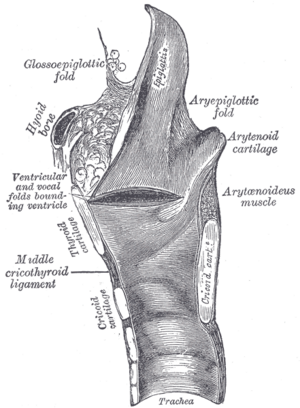 David - Well very briefly, if you're going to make any sound you need a source of sound. For most of what we do when we're speaking it's the vocal folds which vibrate inside the larynx. So that lumpy thing on your neck: the Adams Apple at the front that you can feel with your finger. If you put your finger on it and swallow it moves up and down to show that it's alive and well. There are two muscles in there that vibrate and they produce a buzz. Now I've got an electronic version of a buzz here so this buzz you're about to hear is an electronic larynx.
David - Well very briefly, if you're going to make any sound you need a source of sound. For most of what we do when we're speaking it's the vocal folds which vibrate inside the larynx. So that lumpy thing on your neck: the Adams Apple at the front that you can feel with your finger. If you put your finger on it and swallow it moves up and down to show that it's alive and well. There are two muscles in there that vibrate and they produce a buzz. Now I've got an electronic version of a buzz here so this buzz you're about to hear is an electronic larynx.
Chris - Not a shaver?
David - No, it might sound like one. Here we go.
A voice-box simulating buzz
So that's a buzzing sound and to prove that this simulates what your or my larynx are doing, I'm now going to tell you my name and use this instead of my normal larynx by placing it against my Adams Apple.
Hello my name is David Howard - as spoken using a larynx simulating buzz
Chris - So how's that working? You're just sending a pulse of sound waves in through your throat and it's hitting your vocal chords. You're not breathing and talking as you would do normally, you're just moving your voice box as though you were going to?
David - That's correct. The way you use this is to hold your breath. So you take a breath and go, 'ha,' as if you're going to lift a heavy weight which closes the vocal folds and jams them together so that you can build up pressure in the lungs to support yourself. It also means when you put the buzz in it then stimulates the cavities above in the normal way. The key to speaking is that we have two things available to us. We've got a buzz and we've got a tube and this tube is a squidgy tube which goes from the larynx to the lips, the mouth. And of course, when we're talking we're moving our jaw, our tongue, our lips and that changes the shape of the tube and therefore changes the acoustic characteristics of that tube.
Chris - So can you model that. If you take measurements from somebody and record over time can you build up a profile of what their throat looks like so it's possible to recreate their voice almost?
David - You can and this is something we're now doing. This is looking at how can we electronically synthesize a natural sounding human, starting with the real tube shape of a human being. You put them into a Magnetic Resonance Imaging Machine and if you do that and characterize the tube: I have in front of me two acrylic tubes. This one is shaped like the vowel, 'aah.' It's 17 and-a-half centimeters long and it sounds like this. I've put the buzz in the end.
The sound created by a larynx simulator and acrylic tube modelled on the throat whilst making an 'R' sound.
Chris - So how does that work? How are you producing that particular sound?
David - Well, the way the sound is produced is because the tube itself has an internal shape which is modelled on a real human mouth saying, 'aah.' So if you imagine saying 'aah,' you open the jaw. If you contrast 'aah' with 'ee,' 'ee' has a closed jaw. 'Aah' has an open jaw and I also have a tube for 'ee' which sounds like this:
The sound created by a larynx simulator and acrylic tube modelled on the throat whilst making an 'E' sound.
Chris - Sounds like it went down a bit at the end there, maybe it's getting tired or something?
David - The pitch goes down because the buzz goes down. The key thing is that the shapes are producing 'aah' and 'ee' and what I like to remind singers, if we're talking to singers, is that all you have to sing with is a buzz and a tube that's about 17 and a half centimetres long which is all squidgy, that's it.
Chris - Well, let's look at something which people who make their money from the voice: people who take the rip out of other people and sound like people. How are they doing that because that all comes down to the same business as to why we have accents? I know we're going to have a flurry of 5 million emails as people love the subject of accents. Why do I sound English? Helen sounds English yet a lot of people on the other side of the Atlantic have their own distinct way of sounding.
David - We have the basic speech production apparatus. We all have the same larynx and the same tubes above it but culturally depending on where we're brought up, what are the sounds we hear when we're very young? That begins to determine what we're going to sound like when we speak, and indeed sing, and indeed make music. So if you're trying to imitate, if you're a professional imitator: like, for example, Rory Bremner. He will take a voice and we will try and imitate that voice but he's got a fundamental problem. The fundamental problem is that he's got to do it with his tube and apparatus and he will not have the same tube as the person he is trying to imitate.
 Chris - Now you spent some time with Rory Bremner at the BBC, he's often on telly doing this. He was taking the rip out of Tony Blair. So you've given me a lump of Tony Blair. Here's our good old friend Tony:
Chris - Now you spent some time with Rory Bremner at the BBC, he's often on telly doing this. He was taking the rip out of Tony Blair. So you've given me a lump of Tony Blair. Here's our good old friend Tony:
"It's not the consequence of foreign policy, it's an attack on our way of life" - Tony Blair
Chris - Everyone remembers that speech very well. Here's Rory Bremner doing Tony Blair:
"It's not the consequence of foreign policy, it's an attack on our way of life" - Rory Bremner as Tony Blair
Chris - Now what's really interesting is that I can tell that's not Tony Blair but at the same time it does sound dramatically like him.
David - It does. The acoustics are different in both cases. Tony's was in a big hall and it sounds like a speech. Rory was in a quiet studio. He will never produce exactly the same acoustic signature. He can't because of the shape of his own tubes are different to Tony Blair's.
Chris - So why is he fooling me to a certain extent then? How do I know who that is instantly?
David - Well the key thing he seems to be doing is latching onto some key acoustic characteristics that change when Tony Blair speaks in the way that Tony Blair does it. They're kind of his acoustic mannerisms that he uses when he speaks. What Rory is doing is picking those up, rather like your caricature artist might draw a cartoon with a big nose, and you know who it is even though the actual picture is a circle: two dots and a big nose.
Chris - Well thank you very much, David Howard from the University of York.

26:44 - Music and the Brain
Music and the Brain
with Professor Daniel Levitin, McGill University
Meera - If you think about it, music is a pretty amazing thing. It has the ability to make us really happy but also drive us crazy. Whilst some people love the cheesy tracks of the Spice Girls, or the hip hop beats of Kanye West, others can hate these with a real passion. So what is it about music that has this effect on us? I spoke to Daniel Levitin from McGill University in Montreal about what music actually does to our brains.
 Daniel - Well the remarkable thing about music is that it activates nearly every region of the brain we've mapped so far. Music listening involves the auditory cortex, which is one of the first places in the brain that the music is processed but then it gets shuffled off and different parts of the brain extract pitch from rhythm from timbre and melody and harmony. Even if you're not a musician and even if you're not aware you're doing it the music listening experience involves the frontal lobes trying to figure out what notes are going to come next. That's how we get a sense of surprise and release in music: that Ahhhh feeling that the composer played a note that you really liked. That experience could only happen if subconsciously your brain was trying to figure out what the composer might do. Often when people are listening to music we find visual cortex activation, either because they're imagining movement, or imagining watching a performer.
Daniel - Well the remarkable thing about music is that it activates nearly every region of the brain we've mapped so far. Music listening involves the auditory cortex, which is one of the first places in the brain that the music is processed but then it gets shuffled off and different parts of the brain extract pitch from rhythm from timbre and melody and harmony. Even if you're not a musician and even if you're not aware you're doing it the music listening experience involves the frontal lobes trying to figure out what notes are going to come next. That's how we get a sense of surprise and release in music: that Ahhhh feeling that the composer played a note that you really liked. That experience could only happen if subconsciously your brain was trying to figure out what the composer might do. Often when people are listening to music we find visual cortex activation, either because they're imagining movement, or imagining watching a performer.
Meera - I think the trains and tubes are evidence enough that people are clearly daydreaming as they listen to their iPods®. But now we know what the initial effect on our brain is, what is it about music that makes it so easy to stay in our heads?
 Daniel - I would characterise it as being constituted of multiply redundant or reinforcing cues. What I mean by that is, if you're trying to remember the words there are a lot of things that constrain them. You've got the accent structure, the melody. You've got a rhyming scheme, there are only certain words that will fit at the end of a line. In terms of melody you may not remember all the notes of the melody but if you remember that the melody starts low and it goes high. It might be going [SINGS] and you have to get from one to the other. There are only certain notes that it could be. There's a certain aspect of human memory that's illusory. You don't remember every detail of everything but you construct some of the details at the moment of recollection. So you fill in information that isn't actually in your memory with a plausible substitute. This happens all the time in music.
Daniel - I would characterise it as being constituted of multiply redundant or reinforcing cues. What I mean by that is, if you're trying to remember the words there are a lot of things that constrain them. You've got the accent structure, the melody. You've got a rhyming scheme, there are only certain words that will fit at the end of a line. In terms of melody you may not remember all the notes of the melody but if you remember that the melody starts low and it goes high. It might be going [SINGS] and you have to get from one to the other. There are only certain notes that it could be. There's a certain aspect of human memory that's illusory. You don't remember every detail of everything but you construct some of the details at the moment of recollection. So you fill in information that isn't actually in your memory with a plausible substitute. This happens all the time in music.
Meera - The really amazing thing about music though is that it has the ability to cheer us up and really excite us. How does it do that?
Daniel - We don't know what it is about music and why music does it and not dogs barking but we know something about what's going on and not the why. What I mean is that there is a certain network of structures in the brain, in the limbic system, that begin to fire when we have a variety of pleasurable experiences. These include taking cocaine, or having an orgasm, or eating chocolate and it turns out that when people listen to music that same network of neurons starts to fire. These neurons help to modulate levels of dopamine in the brain. Dopamine is one of the neurotransmitters that essentially makes you feel good. So when you listen to music that you like, you get this actual change of chemical levels in your brain.
Meera - What about the awful songs that drive you crazy?
 Daniel - If you hear music that you don't like that dopamine system won't be activated and if you really don't like the music your medulla, which is the seed of the flight or fright reaction, could be activated. You'll get really agitated and might start to sweat and you might get angry. The American government drove Manuel Noriega out of his compound by playing him 36 hours of ACDC music. That was enough to drive him to surrender. I think we've all had that experience where you're in a shopping mall or something and they're piping in music and you wish it would just stop.
Daniel - If you hear music that you don't like that dopamine system won't be activated and if you really don't like the music your medulla, which is the seed of the flight or fright reaction, could be activated. You'll get really agitated and might start to sweat and you might get angry. The American government drove Manuel Noriega out of his compound by playing him 36 hours of ACDC music. That was enough to drive him to surrender. I think we've all had that experience where you're in a shopping mall or something and they're piping in music and you wish it would just stop.
Meera - Tell me about it. There's nothing worse than an irritating song being belted in your ear. Have you ever thought you didn't like a song, say because it didn't sound like music to you, and then found that after a while you suddenly really like it? What's that about?
Daniel - If a piece of music that you hear is too simple and you can predict every move the composer makes, you might find it pleasurable on the first few listens but you'll rapidly tire of it. If it's a little bit difficult though, you may not like it though because you can't sense any structure. Over time as its secrets are unlocked to you, your brain figures it out. That gives you a sense of ownership of it or a sense of involvement that you don't get if it's all too apparent. You begin to enjoy it and it can become one of your favourite pieces of music.
Meera - With such a difference in the genres of music available to us there's a real divide on what people class as good music. One rumour that goes around is that listening to classical music can have a better effect on your brain and even make you smarter. So to finish off I had to ask him if there was any truth in this. Because, whilst I may listen to a bit of Mozart, my guilty pleasure is that I do blast out a little bit of the cheese every now and then.
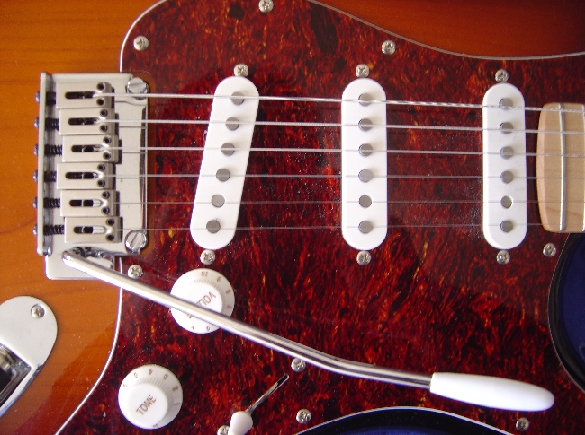 Daniel - Really the most important factor in all of this is whether you like the music or not. If you like it it's going to engage the pleasure centres and if you hate it it's going to engage the fear centres. Apart from that there's no evidence that listening to classical is going to engage brain regions in a more sophisticated way than listening to hip hop. If you listen to music with lyrics you'll get different activations to music without lyrics. Music with a beat is going to give you activation in the cerebellum that you wouldn't get from music without a beat. So comparing James Brown to Enya, for example, or James Brown to Vivaldi: James has more beat so there's going to be more rhythmic centres involved. It would be wrong to conclude that one kind of music is preferred by the brain or is seen as better by the brain.
Daniel - Really the most important factor in all of this is whether you like the music or not. If you like it it's going to engage the pleasure centres and if you hate it it's going to engage the fear centres. Apart from that there's no evidence that listening to classical is going to engage brain regions in a more sophisticated way than listening to hip hop. If you listen to music with lyrics you'll get different activations to music without lyrics. Music with a beat is going to give you activation in the cerebellum that you wouldn't get from music without a beat. So comparing James Brown to Enya, for example, or James Brown to Vivaldi: James has more beat so there's going to be more rhythmic centres involved. It would be wrong to conclude that one kind of music is preferred by the brain or is seen as better by the brain.
Meera - That was Professor Daniel Levitin explaining the regions of the brain stimulated by music and why it's so easy for songs to get stuck in our heads or for us to get annoyed by music in shopping malls and by ACDC.

33:32 - Evolution of Music
Evolution of Music
with Dr Ian Cross, University of Cambridge
Ian - Hello.
Helen - Ian's been researching the definition of music as well as the evolutionary origin of where music came from. I guess my first question, Ian, is if we had to define music what is it?
 Ian - Well it's probably not the sound of Mozart on a CD or the sound of AC/DC on a CD. It's not just sound, it's action. It's probably not just sound of action but also interaction. We find that more in traditional cultures than we find it in the West. We tend to find it very easy to think of music just as sound, something you listen to for purely pleasurable purposes. In many other cultures, even the West it really does a lot of different jobs.
Ian - Well it's probably not the sound of Mozart on a CD or the sound of AC/DC on a CD. It's not just sound, it's action. It's probably not just sound of action but also interaction. We find that more in traditional cultures than we find it in the West. We tend to find it very easy to think of music just as sound, something you listen to for purely pleasurable purposes. In many other cultures, even the West it really does a lot of different jobs.
Helen - What kind of jobs does music do?
Ian - Well, very simply you listen to a piece of music - why are you listening to a piece of music at that particular time? Probably to regulate your own affective state; to change your mood. It's doing something there. You, let's say, sing in a choir. How is singing in a choir, particularly if you don't have much of a voice (and there are many people who sing in choirs who don't have much of a voice), so why are they singing? Because of a sense; of a way that music has of enhancing affiliation; of allowing a sense of community to emerge in a non-conflictual situation.
Helen - Is there a big difference between listening to music and creating music? I would say the moods that music can make you feel and listening to different types of music. You listen to very get-up-and-go music in the morning or quite quiet, lovely, mellow music in the evening to wind yourself down. Is there a difference between the performing and the listening, do you think?
 Ian - There is in our culture and there is in many other cultures but there are many cultures where people do and listen to music. There's no real distinction between the two. You just are musical in the way that you'll have language you have musicality. Some people are good at it, some people aren't. Everyone's got it and uses it to receive and to create, to produce.
Ian - There is in our culture and there is in many other cultures but there are many cultures where people do and listen to music. There's no real distinction between the two. You just are musical in the way that you'll have language you have musicality. Some people are good at it, some people aren't. Everyone's got it and uses it to receive and to create, to produce.
Helen - The music and language seem to be a very similar thing. I take it language came first and we then had music. Is music a very ancient thing. I take it it's been around in human societies for a very long time.
Ian - Certainly in our culture it would seem to make sense that yes, we had language doing a proper job first and then we've got music coming along and ligging on the back of language. Actually, music is probably doing stuff that we needed at the same time as we needed language in terms of enabling a fluidity of direction. Particularly, managing situations of social uncertainty where no one's quite sure what's going on. The situation's on the edge. If people start saying something and talking about the determinants, the structure of the situation to each other it could get out of hand. Music in that context, in that situation seems to act as a kind of lubricant to allow people to interact fluidly and easily without getting into conflict with each other.
Chris - What about a war dance then?
Ian - Well, that's great. You've got a bunch of people, all of whom are doing the same thing. As a group activity it's oriented towards the destruction of another group but it's still a group activity.
Chris - Which do we think came first then? Do we think that language came first and then the music cropped up or do you think that people started making musical sounds and then developed that into something we now call language.
 Ian - I think people started making social sounds. Those social sounds eventually partial out roughly, I think, when we get to Homo sapiens a couple of hundred thousand years ago into what we might now think of as music and language which I would think of as complementary components of the human communicative toolkit.
Ian - I think people started making social sounds. Those social sounds eventually partial out roughly, I think, when we get to Homo sapiens a couple of hundred thousand years ago into what we might now think of as music and language which I would think of as complementary components of the human communicative toolkit.
Helen - If we take a global view of music and the wonderful varieties there must be out there of different types of music. Do we all think the same sorts of sounds are nice or are there different interpretations on what is a beautiful sound in different parts of the world.
Ian - Extremely so. If we'd like to play a little clip of Ndroje balendro.
Sample of Ndroje balendro music
Chris - I think there's an easier way that the Americans could have got Noriega out, you know.
Helen - It sounds like a traffic jam. What's going on there? Tell us about that.
Ian - Well, you have a group of Central African Pygmies each with a little bark horn. Each one can only play one note so each person is only playing one note. What you have is hocketing, antiphonal performance: on person, then another and another and another.
Helen - Like hand bells?
Ian - A bit like hand bells. You've got to be right on the button. Of course the tuning of them is nothing like we'd anticipate with tuning.
Helen - There must have been hundreds of them. How many were there? Dozens and dozens, it sounds like.
Ian - No, it was probably about seven.
Helen - Only seven?
Ian - Yep.
Helen - That's quite amazing. Have we got another clip? Which one have we got, Chris?
Sample of Wanga music
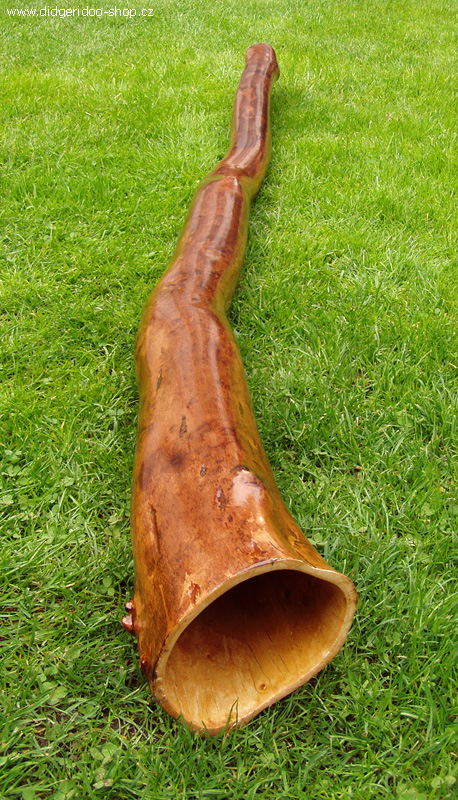 Chris - I'm going to be honest and say I reckon that's probably Antipodean. Is it, Ian?
Chris - I'm going to be honest and say I reckon that's probably Antipodean. Is it, Ian?
Ian - As it happens, yes. It's from the northern territories and is an example of Wonga which is music, history, law and education. All of those things. It's not just something you listen to because you think it's nice, although there's someone out there who probably does think it's nice.
Helen - They tell stories and all those kinds of things as well?
Ian - Yeah and specify property rights. What we think of as music in that context is fulfilling a range of functions that we would assign in our culture to the judiciary and the police.
Chris - We have a lawyer for that but is it because it helps you to remember? If you put something to music does it mean you're more likely to get all the bits right because you know how the tune goes? We seem to be very good at remembering how tunes go but sometimes remembering all the intricate details can be difficult.
Ian - Yeah. That's true. The other advantage of using music is that you can dispense with lawyers.
Why does music move us to tears?
We put this to Dr Ian Cross:
A whole variety of reasons but music does seem to have profound affective effects. That is, it works deeply on our emotions. Daniel Levitin was talking previously about some ways in which limbic centres in the brain are activated by experiencing music. A lot of this probably depends on prior experience. You probably wouldn't be moved to tears by hearing either of those two previous clips [Ndroje balendro and Wonga]. Chris: I was! Ian: For thirty-six hours, perhaps. But you could be moved to tears simply on the basis of association between a piece of music and a particular episode of your life and a particular previous position or preference to use a particular type of music to do things like move yourself to tears.Chris: It's stimulating a memory which is itself associated with some emotion and that's why it's making you feel happy or sad. Ian: Most likely.

Could meditation put you into REM sleep?
We put this to Dr Ian Cross:
Hmm. Not terribly certain about that. I suspect that there is evidence that there is some musically central or rhythmic structures, tempi, if you like.
There are certain structures that one can link into, one can entrain one's attentional pulse/attentional periodicities to. As to whether or not it requires it to be shamanic in order to happen, it's not a matter.

What is Brown Noise?
We put this question to Dr Ian Cross:
Ian: Er, probably not. Other than, "assume the crash position!"
Chris: Wasn't there some tests done by the American military?
Ian: Yeah. The trouble is with sound, it leaks out so it would be difficult to prevent the same thing happening to your own soldiers were it to have been efficacious. The other thing about sound, it does this wonderful thing. You can diminish the effect by standing further away. This as a strategy doesn't appear to have been something envisaged by those who were trying to test it.
Are wrinkles in other animals distinguising like fingerprints?
It's a great question. Thanks very much for that and actually something that I (Helen) have looked at myself. It is not maybe wrinkles but patterns that animals have, that fish have on their faces and the ability to actually identify individuals. I did a study of a huge fish called the humphead wrasse or Maori wrasse, which are beautiful big reef creatures by taking photographs of their patterns, beautiful patterns. They're called Maori wrasse because they look a bit like the tattoos that New Zealand indigenous people have on their faces. I could actually identify individual fish and look at when they were coming to mate and how they were aggregating in one particular area. I think yes absolutely, fish can have these identifiable features on them. I don't know about wrinkles. The other thing we have with things like whales and dolphins is that lots of things grow on them: barnacles and little bits of creatures and things like that. People doing population assessments can also count whales by taking photographs of their tails and the nooks and crannies they have on their huge flukes as they come up to dive, and that can help you to identify how many you've got in a population.

44:17 - Speed of Caves?
Speed of Caves?
Jan Zalasiewicz, University of Leicester:Carbon dioxide in the atmosphere dissolves in rainwater and produces weak acid - carbonic acid. This weak acid reacts with rocks and other materials and can basically dissolve them. So it will take limestone, it will even take some of the unstable minerals in granite and basalt and such like and will dissolve them, neutralising itself in the process. So one of the things that it will do is if you have more carbon dioxide in the atmosphere as we have now, then the level of acid in the rain therefore becomes higher and therefore amounts and rates of this dissolution process will become greater and in fact are currently becoming greater.
Dave Mattey, Professor of Isotope Geology, Earth Science at Royal Holloway: In answer to the question the caves are certainly formed by solution of limestone by carbonic acid, but it's not really the level of CO2 in the atmosphere that does the damage that causes the water to be acidic enough to form caves. The atmosphere at the present time contains about 390ppm of carbon dioxide which is about 0.03%, which will dissolve in rain to form a very weak solution of carbonic acid. This will only slowly dissolve limestone but not at a sufficiently fast rate to form very large cavities or caves. What forms very large caves is the fact that they are covered by a layer of soil and it's the formation of carbon dioxide in the soil which can grow to quite large concentrations, sometimes up to maybe 1% or up to 4 or 5 percent sometimes in the more humid parts of the world. When rainfall falls through this very carbon dioxide rich soil zone it forms a very strong solution of carbonic acid. It's this very strong carbonic acid that can form cave cavities in limestone much more quickly over a period of tens to hundreds of thousands of years. So any change in the carbon dioxide level of the atmosphere: we're currently at 390ppm and the models predict it might go up to perhaps 420, perhaps even 450ppm in the next 50 years or so. This change doesn't have any impact really on the formation of caves. One other thing is that one of the outcomes of rising atmospheric CO2 levels is that it may affect the productivity of plants. There maybe an indirect link between rising CO2 levels and the formation of caves. If the plant and forest canopy become more vigorous then the soil might be expected to produce more CO2 so the caves might conceivably begin to grow a bit faster.
Why is singing myself less distractin than listening to music?
We put this question to Dr Ian Cross:
Two possible reasons: there is some evidence that people suffering from Asperger's syndrome may be aurally hyper-sensitive. I think a more plausible reason is likely to be that listening to something someone else has created is not something you can control whereas if you are producing it yourself it obviously is. It's likely to be a control issue.
Why are some voices more relaxing than others?
We put this question to Professor David Howard:
Well, when we listen to sounds like speech we've of course learnt about speech and we've had experiences in our lives that link to sound. We've learnt the patterns of certain speech and it's associated with certain things. If you've heard speech from other people from your past, perhaps your mum or your dad or a loved one you're picking up those patterns in other people. It just triggers memories.
Chris: If we find someone intensely annoying to listen to, not just the content of what they are saying but the way they sound because we all know people like that, people have certain laughs. Why do we find certain voices intensely annoying?David: My guess is again that it is some sort of conditioning back to some sort of experience in early life. Perhaps it was a teacher who told you off or whatever that made you pick up that particular pattern. So it's another stored pattern, it's a memory.
Why does your mouth feel cold when you chew spearmint?
The reason for this is because spearmint contains menthol. Menthol triggers the same receptor as cold. It's something called the TRP-M8 receptor or nerve fibres in the mouth. It fools them into thinking they're colder than they really are. So when you breathe in, your mouth feels colder than it really is because it's activated this particular ion channel in the surface of the nerve fibre in your mouth. You think things are a lot colder than they really are. It's just a trick, a neurological trick, so you're not any colder really.












Comments
Add a comment